FGF19/FGFR4 signaling contributes to the resistance of hepatocellular carcinoma to sorafenib
- PMID: 28069043
- PMCID: PMC5223586
- DOI: 10.1186/s13046-016-0478-9
FGF19/FGFR4 signaling contributes to the resistance of hepatocellular carcinoma to sorafenib
Abstract
Background: Sorafenib, a multi-kinase inhibitor, is used as a standard therapy for advanced hepatocellular carcinoma (HCC). However, complete remission has not been achieved and the molecular basis of HCC resistance to sorafenib remains largely unknown. Previous studies have shown that fibroblast growth factor 19 (FGF19) expression correlates with tumor progression and poor prognosis of HCC. Here, we demonstrate the novel role of FGF19 in HCC resistance to sorafenib therapy.
Methods: FGF19 Knockdown cells were achieved by lentiviral-mediated interference, and FGFR4 knockout cells were achieved by CRISPR-Cas9. Protein levels of FGF19, FGFR4 and c-PARP in various HCC cell lines were measured by Western blotting analysis. Cell viability was determined by MTS assay, apoptosis was determined by DAPI nuclear staining and Western blot of c-PRAP, and ROS generation was determined by DCFH-DA staining and electrochemical biosensor.
Results: We showed that FGF19, when overexpressed, inhibited the effect of sorafenib on ROS generation and apoptosis in HCC. In contrast, loss of FGF19 or its receptor FGFR4 led to a remarkable increase in sorafenib-induced ROS generation and apoptosis. In addition, knockdown of FGF19 in sorafenib-resistant HCC cells significantly enhanced the sensitivity to sorafenib. Importantly, targeting FGF19/FGFR4 axis by ponatinib, a third-generation inhibitor of chronic myeloid leukemia, overcomes HCC resistance of sorafenib by enhancing ROS-associated apoptosis in sorafenib-treated HCC.
Conclusion: Our results provide the first evidence that inhibition of FGF19/FGFR4 signaling significantly overcomes sorafenib resistance in HCC. Co-treatment of ponatinib and sorafinib may represent an effective therapeutic approach for eradicating HCC.
Keywords: Drug resistance; FGF19; FGFR4; Hepatocellular carcinoma; Sorafenib; Synergistic effect.
Figures
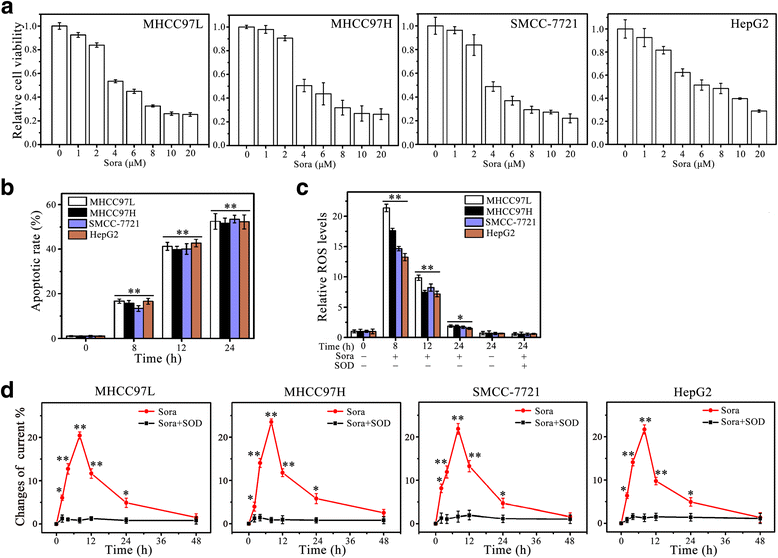

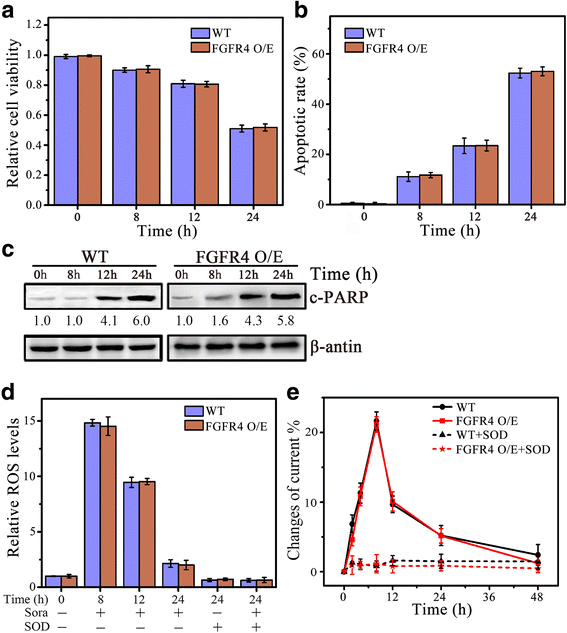
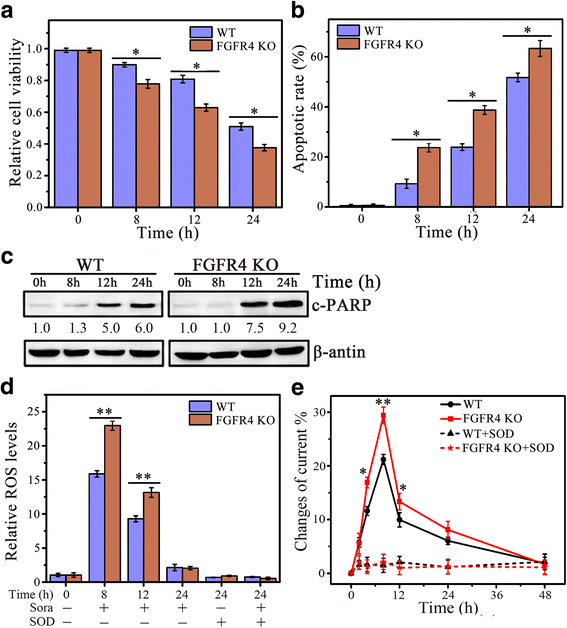
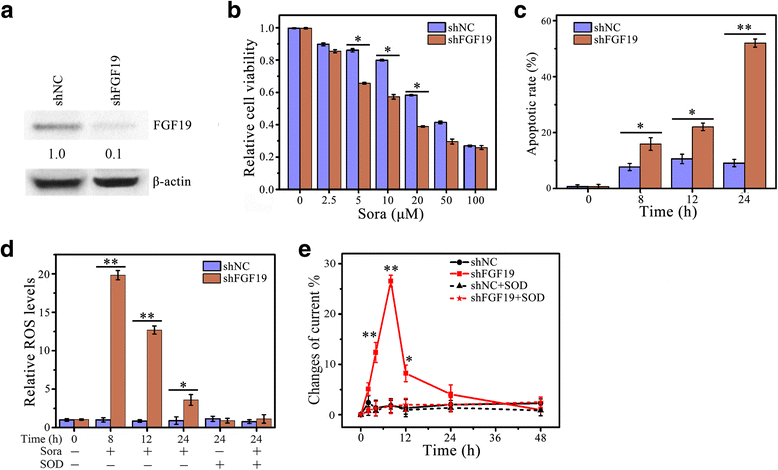
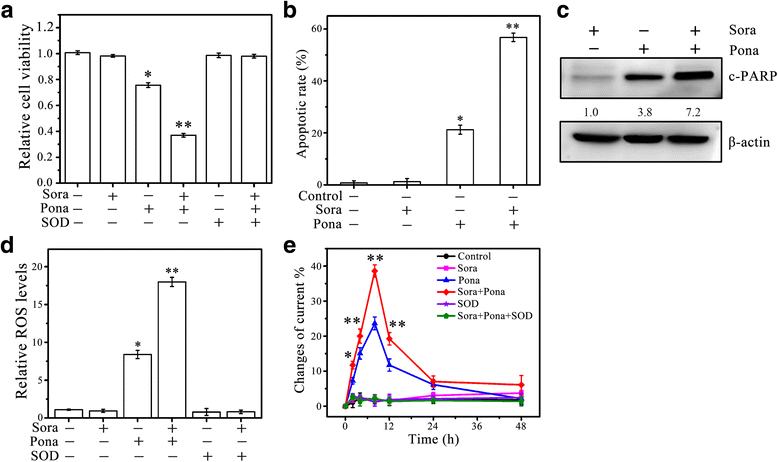
Similar articles
-
Implications of FGF19 on sorafenib-mediated nitric oxide production in hepatocellular carcinoma cells - a short report.Cell Oncol (Dordr). 2018 Feb;41(1):85-91. doi: 10.1007/s13402-017-0354-4. Epub 2017 Oct 5. Cell Oncol (Dordr). 2018. PMID: 28983785
-
FGF19 promotes epithelial-mesenchymal transition in hepatocellular carcinoma cells by modulating the GSK3β/β- catenin signaling cascade via FGFR4 activation.Oncotarget. 2016 Mar 22;7(12):13575-86. doi: 10.18632/oncotarget.6185. Oncotarget. 2016. PMID: 26498355 Free PMC article.
-
FGF19 Protects Hepatocellular Carcinoma Cells against Endoplasmic Reticulum Stress via Activation of FGFR4-GSK3β-Nrf2 Signaling.Cancer Res. 2017 Nov 15;77(22):6215-6225. doi: 10.1158/0008-5472.CAN-17-2039. Epub 2017 Sep 26. Cancer Res. 2017. PMID: 28951455
-
Targeted inhibition of the FGF19-FGFR4 pathway in hepatocellular carcinoma; translational safety considerations.Liver Int. 2014 Jul;34(6):e1-9. doi: 10.1111/liv.12462. Epub 2014 Jan 24. Liver Int. 2014. PMID: 24393342 Review.
-
FGF19-FGFR4 Signaling in Hepatocellular Carcinoma.Cells. 2019 Jun 4;8(6):536. doi: 10.3390/cells8060536. Cells. 2019. PMID: 31167419 Free PMC article. Review.
Cited by
-
Src is essential for the endosomal delivery of the FGFR4 signaling complex in hepatocellular carcinoma.J Transl Med. 2021 Apr 1;19(1):138. doi: 10.1186/s12967-021-02807-4. J Transl Med. 2021. PMID: 33794926 Free PMC article.
-
EPS364, a Novel Deep-Sea Bacterial Exopolysaccharide, Inhibits Liver Cancer Cell Growth and Adhesion.Mar Drugs. 2021 Mar 22;19(3):171. doi: 10.3390/md19030171. Mar Drugs. 2021. PMID: 33809909 Free PMC article.
-
DNMT3b/OCT4 expression confers sorafenib resistance and poor prognosis of hepatocellular carcinoma through IL-6/STAT3 regulation.J Exp Clin Cancer Res. 2019 Nov 26;38(1):474. doi: 10.1186/s13046-019-1442-2. J Exp Clin Cancer Res. 2019. PMID: 31771617 Free PMC article.
-
The Double-Faced Role of Nitric Oxide and Reactive Oxygen Species in Solid Tumors.Antioxidants (Basel). 2020 Apr 30;9(5):374. doi: 10.3390/antiox9050374. Antioxidants (Basel). 2020. PMID: 32365852 Free PMC article. Review.
-
Transcriptional regulation of NDUFA4L2 by NFIB induces sorafenib resistance by decreasing reactive oxygen species in hepatocellular carcinoma.Cancer Sci. 2023 Mar;114(3):793-805. doi: 10.1111/cas.15648. Epub 2022 Nov 29. Cancer Sci. 2023. PMID: 36369883 Free PMC article.
References
-
- Memon K, Kulik L, Lewandowski RJ, Mulcahy MF, Benson AB, Ganger D, et al. Radioembolization for hepatocellular carcinoma with portal vein thrombosis: impact of liver function on systemic treatment options at disease progression. J Hepatol. 2013;58:73–80. doi: 10.1016/j.jhep.2012.09.003. - DOI - PMC - PubMed
-
- Chang TS, Huang Y-H. Role of SENP1 in HBx-induced cell migration and stemness-related properties in hepatocellular carcinoma. Cancer Res. 2016;76:1720–20. doi: 10.1158/1538-7445.AM2016-1720. - DOI
MeSH terms
Substances
LinkOut - more resources
Full Text Sources
Other Literature Sources
Medical
Research Materials
Miscellaneous

